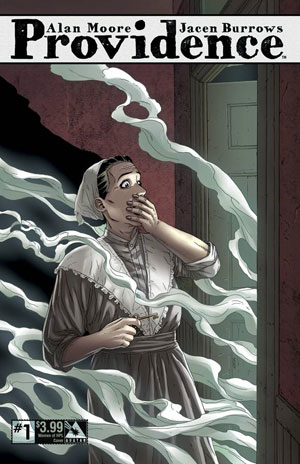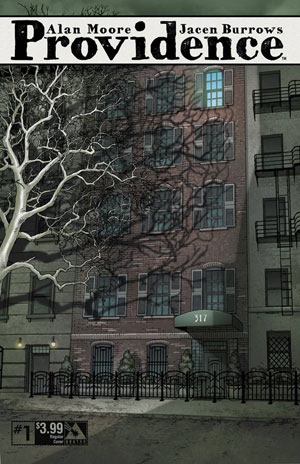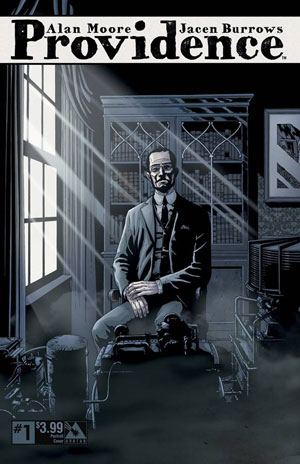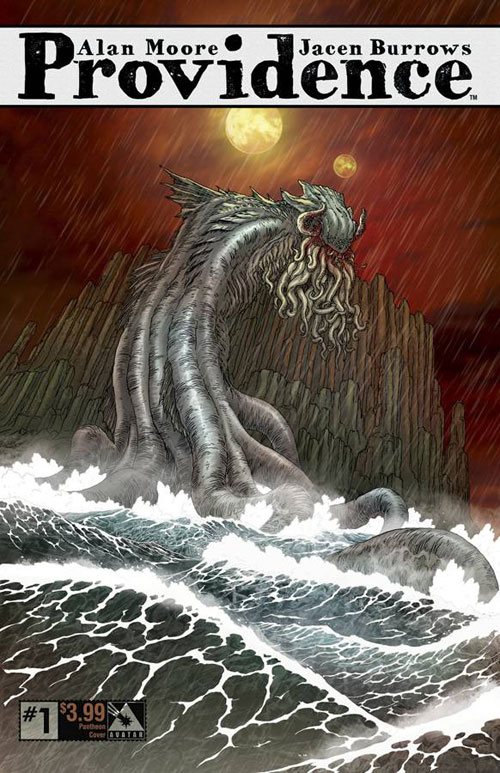Alan Moore Talks About Providence
May 24, 2015
 Almost twenty years ago, asked to submit some modern H.P. Lovecraft-founded writings to a prose anthology, I commenced work on an experimental piece based upon Lovecraft’s sonnet-cycle, the peculiar Fungi from Yuggoth. Titled Yuggoth Cultures, the initial nebulous idea was that of treating each of Lovecraft’s sonnets as a fungal spore placed in an individual Petri dish, taking its title or its imagery and seeing what might usefully be grown from it. Around the halfway point of the endeavour, though, on losing the only existing copy of most of the venture in a taxi, it was decided that one of the few surviving pieces, a complete short story inspired by and named after The Courtyard, would be by itself sufficient to make good on my commitment. It was, I thought, a fairly fresh approach to writing fiction based upon the work of Lovecraft, trying to avoid the dull pastiches and the clichés that had typified a lot of fictions of this nature by setting the narrative in what was then the future science-fiction landscape of imaginary 21st century America, while in the racism, misogyny and anti-Semitism of its first-person protagonist, FBI agent Aldo Sax, the story was to some extent able to comment of those tendencies in Lovecraft as an individual.
Almost twenty years ago, asked to submit some modern H.P. Lovecraft-founded writings to a prose anthology, I commenced work on an experimental piece based upon Lovecraft’s sonnet-cycle, the peculiar Fungi from Yuggoth. Titled Yuggoth Cultures, the initial nebulous idea was that of treating each of Lovecraft’s sonnets as a fungal spore placed in an individual Petri dish, taking its title or its imagery and seeing what might usefully be grown from it. Around the halfway point of the endeavour, though, on losing the only existing copy of most of the venture in a taxi, it was decided that one of the few surviving pieces, a complete short story inspired by and named after The Courtyard, would be by itself sufficient to make good on my commitment. It was, I thought, a fairly fresh approach to writing fiction based upon the work of Lovecraft, trying to avoid the dull pastiches and the clichés that had typified a lot of fictions of this nature by setting the narrative in what was then the future science-fiction landscape of imaginary 21st century America, while in the racism, misogyny and anti-Semitism of its first-person protagonist, FBI agent Aldo Sax, the story was to some extent able to comment of those tendencies in Lovecraft as an individual.
I’d found the world the story conjured up an interesting place that I might at some point return to in the future, and this urge was only strengthened by Avatar’s adaptation of the story as a comic narrative by the impeccable Antony Johnston and the extraordinary Jacen Burrows.
 Thus it was that I found myself working with Jacen upon a comic-strip sequel to the original prose story, exploring some of its implications... notably those posed by the blanket-covered figure in The Courtyard’s purported photograph of J. Edgar Hoover... in the work published in 2011 as Neonomicon. As pleased as I was by the way that the book expanded on the initial agenda of The Courtyard in its efforts to create a modern and progressive form of Lovecraftian horror fiction, I also realised that the story, with its implication that in some way Lovecraft’s fiction had been based upon his knowledge of real-life phenomena, had raised more questions than it answered. How, exactly, had the hard-headed Rhode Island rationalist received the inspiration for his tales, in keeping with this new scenario?
Thus it was that I found myself working with Jacen upon a comic-strip sequel to the original prose story, exploring some of its implications... notably those posed by the blanket-covered figure in The Courtyard’s purported photograph of J. Edgar Hoover... in the work published in 2011 as Neonomicon. As pleased as I was by the way that the book expanded on the initial agenda of The Courtyard in its efforts to create a modern and progressive form of Lovecraftian horror fiction, I also realised that the story, with its implication that in some way Lovecraft’s fiction had been based upon his knowledge of real-life phenomena, had raised more questions than it answered. How, exactly, had the hard-headed Rhode Island rationalist received the inspiration for his tales, in keeping with this new scenario?
This is the process that has led, inevitably, to the lengthy major narrative that is in many ways a culmination of the processes begun last century in Yuggoth Cultures, the imminent Providence (MAR150951), once more with Jacen Burrows crafting what must be the most staggering work of his exemplary career thus far. I think it’s fair to say that what we have accomplished is perhaps the most considered and ambitious comic strip approach to Lovecraft as a writer and a man that has yet been attempted, and that if it works as it’s intended to it should accomplish several things: I am attempting to apply some of the principles that I brought to my re-imaginings of other genres to Lovecraftian horror, in that we are hopefully situating the notably bizarre inhabitants of Lovecraft’s fiction in a world that is as absolutely credible and as immersive as we’re capable of conjuring.
 We are also attempting to connect the disparate characters and concepts of the original stories in a manner that is more coherent and compelling than the standard stylings of the ‘Cthulhu mythos’, and is hopefully far closer to the kind of connectivity that HPL himself might have envisaged, though expressed in a much different way and in a different medium. Then, of course, there is our treatment of Lovecraft himself.
We are also attempting to connect the disparate characters and concepts of the original stories in a manner that is more coherent and compelling than the standard stylings of the ‘Cthulhu mythos’, and is hopefully far closer to the kind of connectivity that HPL himself might have envisaged, though expressed in a much different way and in a different medium. Then, of course, there is our treatment of Lovecraft himself.
Providing both sequel and prequel to The Courtyard and to Neonomicon, the story has required that we address the Providence materialist/visionary as a character and that, though necessarily a fiction, our portrayal be as true to Lovecraft’s life and his opinions as was possible. To this end, Providence is an attempt to marry Lovecraft’s history with a mosaic of his fictions, setting the man and his monsters in a persuasively real America during the pivotal year of 1919: before Prohibition and Weird Tales, before Votes for Women or the marriage to Sonia, before the Boston Police Strike and Cthulhu. This is a story of the birth of modern America, and the birth of modern American terror. It is also, in my opinion, the most spectacular outgrowth of our original fungus-sample thus far, and I look forward with interest to the reaction of the modern Lovecraft audience and to that of modern Lovecraft scholarship. Above all this is a reappraisal of Lovecraft, not as an icon of the horror story’s past, but of its future. It may be that the stars are finally right.
~Alan Moore
**********
Providence #1 (MAR150951) is in comic shops May 27.
 |




